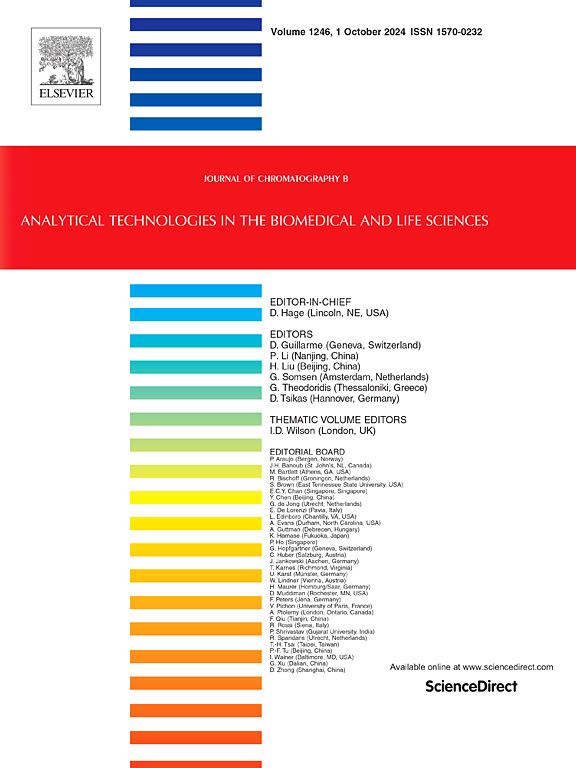分级富集驱动超滤快速鉴定连翘中3-凝乳胰蛋白酶样蛋白酶抑制剂Vahl
IF 2.8
3区 医学
Q2 BIOCHEMICAL RESEARCH METHODS
引用次数: 0
摘要
由于草药提取物的化学复杂性,高质量的天然产物酶抑制剂的发现仍然是一个重大挑战。虽然基于亲和的配体捕捞和超滤是筛选活性化合物的快速方法,但非特异性相互作用往往会干扰高质量活性化合物与靶酶的结合,导致捕捞的成分生物活性弱或无生物活性。为了克服这一限制,我们通过将亲和超滤(AUF)与固相萃取(SPE)相结合,开发了一种新的分层富集驱动超滤策略。以连翘(Forsythia suspensa, Thunb.)为研究对象。筛选3-凝乳胰蛋白酶样蛋白酶(3CLpro)抑制剂。最初,利用SPE将粗提取物分成三个基于极性的部分,以降低化学复杂性并丰富生物活性成分。酶活性测定指导选择最具活性的部分。随后,采用优化的AUF方法(pH 6.0, 30°C, 20 min)结合液相色谱-质谱法从选定的50%甲醇极性馏分中筛选潜在的生物活性化合物。成功鉴定了3种3CLpro抑制剂。值得注意的是,IFT首次被报道为3CLpro抑制剂,具有显着的生物活性,对3CLpro的IC₅₀为10.86±2.39 μM,对SARS-CoV-2的EC₅₀为11.12±1.05 μM (SI = 6.91)。这些发现突出了其作为抗病毒药物开发的有前途的先导化合物的潜力。总之,本研究为快速发现高质量活性天然产物提供了一种简单有效的策略。本文章由计算机程序翻译,如有差异,请以英文原文为准。
Hierarchical enrichment driven ultrafiltration for rapid identification of 3-chymotrypsin-like protease inhibitors from Forsythia suspensa (Thunb.) Vahl
The discovery of high-quality natural product-based enzyme inhibitors remains a major challenge due to the chemical complexity of herbal extracts. Although affinity-based ligand fishing and ultrafiltration are rapid methods for screening active compounds, non-specific interactions often interfere with the binding of high-quality active compounds to target enzymes, resulting in the fished components with weak or no biological activity. To overcome this limitation, we developed a novel hierarchical enrichment-driven ultrafiltration strategy by integrating affinity ultrafiltration (AUF) with solid-phase extraction (SPE). A case study was conducted on Forsythia suspensa (Thunb.) Vahl to screen for 3-chymotrypsin-like protease (3CLpro) inhibitors. Initially, the crude extract was fractionated into three polarity-based portions using SPE to reduce chemical complexity and enrich bioactive constituents. Enzyme activity assays guided the selection of the most active fraction. Subsequently, an optimized AUF approach (pH 6.0, 30 °C, 20 min) coupled with liquid chromatography-mass spectrometry was employed to screen potential bioactive compounds from the selected 50 % methanol polar fraction. Three 3CLpro inhibitors were successfully identified. Notably, IFT was reported for the first time as a 3CLpro inhibitor, exhibiting significant bioactivity, with an IC₅₀ of 10.86 ± 2.39 μM against 3CLpro and an EC₅₀ of 11.12 ± 1.05 μM (SI = 6.91) against SARS-CoV-2. These findings highlight its potential as a promising lead compound for antiviral drug development. In summary, this study provides a simple and effective strategy for the rapid discovery of high-quality active natural products.
求助全文
通过发布文献求助,成功后即可免费获取论文全文。
去求助
来源期刊

Journal of Chromatography B
医学-分析化学
CiteScore
5.60
自引率
3.30%
发文量
306
审稿时长
44 days
期刊介绍:
The Journal of Chromatography B publishes papers on developments in separation science relevant to biology and biomedical research including both fundamental advances and applications. Analytical techniques which may be considered include the various facets of chromatography, electrophoresis and related methods, affinity and immunoaffinity-based methodologies, hyphenated and other multi-dimensional techniques, and microanalytical approaches. The journal also considers articles reporting developments in sample preparation, detection techniques including mass spectrometry, and data handling and analysis.
Developments related to preparative separations for the isolation and purification of components of biological systems may be published, including chromatographic and electrophoretic methods, affinity separations, field flow fractionation and other preparative approaches.
Applications to the analysis of biological systems and samples will be considered when the analytical science contains a significant element of novelty, e.g. a new approach to the separation of a compound, novel combination of analytical techniques, or significantly improved analytical performance.
 求助内容:
求助内容: 应助结果提醒方式:
应助结果提醒方式:


